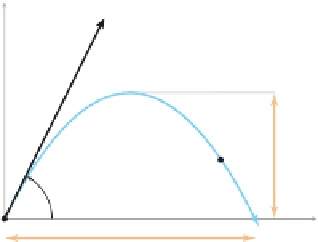Game Development Reference
In-Depth Information
To study projectile mo-
tion where acceleration is
solely due to gravity, which
is a constant and acts along
a cardinal axis, let's estab-
lish a 2D coordinate space
where +y is up and x is
the horizontal axis. With-
out loss of generality we can
rotate our plane such that
it contains the initial veloc-
ity, and thus the entire tra-
jectory of the particle. We
choose +x in the horizontal
direction of the initial veloc-
ity. We also simplify things
by setting the origin at the object's initial position. This notation (along
with a few other items that we'll need in a moment) are illustrated in
Figure 11.13.
Reviewing the notation in Figure 11.13, we see that we can express the
position of the particle as a function of time either as
p
(t), or we can refer
to an individual coordinate with x(t) and y(t). Instantaneous velocity (not
shown on the diagram), can be denoted in vector form either as
v
(t) or
using derivative notation as
p
(t). The scalar velocity components will be
denoted using derivative notation as x(t) and y(t). The initial position and
velocity will be denoted by adding a subscript 0 ( y
0
is the initial vertical
velocity). We denote the acceleration due to gravity as either g or
g
.
Let's state the equations for velocity and position using the notation
just described:
V
0
=
P
0
= (
X
0
,
Y
0
)
S
0
=
V
0
+Y
H
P
(
T
)=
(
X
(
T
),
Y
(
T
)
)
+X
D
Figure 11.13
Projectile motion
p
(t) =
v
0
+ t
g
,
x(t) = x
0
,
y(t) = y
0
+ gt,
(11.20)
p
(t) = t
v
0
+ (t
2
/2)
g
, x(t) = tx
0
, y(t) = t y
0
+ (1/2)gt
2
. (11.21)
The distances labeled h and d in Figure 11.13 are often of interest; they
are the apex height and horizontal travel distance, respectively. As dis-
cussed earlier in a one-dimensional context, the maximum height is reached
when all of the initial velocity in the upwards direction has been consumed
by gravity, in other words when y(t) = 0. This occurs at time
t
a
= − y
0
/g,
Time to reach apex









Search WWH ::

Custom Search